While there are only a few species of snakes in North Dakota, one being a rattlesnake, there are strict laws when it comes to ownership of these reptiles.
In North Dakota, by state law, residents are prohibited to keep venomous snakes as well as constrictors.
If you wish to own a venomous reptile, you must get a permit, which is almost impossible to do in this state since they will only be issued for educational research or preservation purposes.
While it might be exciting to see a cool snake out in the wild and you might be tempted to take it home, it is actually better to purchase a captive-bred snake legally instead. That way, not only are they accustomed to captivity, but you can also rest assured that they have been socialized as well.
You also won’t be breaking any state laws!
Whether you are interested in getting a pet snake and you live in the state of North Dakota or just want to know more about the native snakes in your area, you have come to the right place.
Here is our list of Snakes in North Dakota as well as important information regarding them:
Table of Contents
Snakes in North Dakota
1. Common Garter Snake
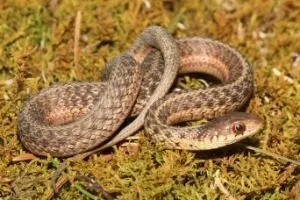
- Experience Level: Beginner
- Family: Colubridae
- Scientific Name: Thamnophis sirtalis
- Other Names: Gartersnake, Common Gartersnake
- Adult Size: between 23 and 32 inches
- Lifespan: 2 years (in the wild); 10 years (in captivity)
- Average Price Range: $20 to $300 per snake
While Garter snakes are quite friendly when it comes to handling and seem to make really great pets.
There is an abundance of this species available in the wilderness, however, taking them from their natural habitat is illegal.
Captive-bred Garter Snakes are docile, friendly, non-venomous, and curious beings that will explore your hands and wrists. They are not constrictors, which is what makes them easy to handle and fun to keep as pets.
They also do not have any fangs for biting. However, they can bite and have a few rows of tiny teeth. If you happen to get nipped, it should be cleaned properly or it might get infected. In rare cases, some people are even allergic to their saliva, so keep that in mind.
They can make homes out of most habitats but prefer to live in meadows, woodlands, forests, hillsides, marshes, and open canopy or freshwater wetlands. They can most often be found near aquatic habitats, where they can flee when predators are nearby; they are very excellent swimmers.
Common Garter Snakes can be identified by their three lightly-colored stripes that run along the length of their black, brown, olive, or gray bodies. These stripes may vary in color depending on the snake, but they will typically be yellow, blue, white, green, or brown.
They are considered low-level predators, meaning that they feed on smaller animals like earthworms, newts, toads, and such, while these snakes are prey to predators that sit higher on the food web.
2. Plains Gartersnake

- Experience Level: Beginner
- Family: Colubridae
- Scientific Name: Thamnophis radix
- Adult Size: 16 to 28 inches
- Lifespan: 5 years; sometimes up to 8 years
- Average Price Range: $20 to $300 per snake (depending on type and size)
These non-venomous snakes are friendly by nature, making them a great pet for beginners. They are also relatively small, meaning they aren’t fussy with tank size and are relatively easy to care for.
They are black with a distinctive, long yellow or orange stripe running along the whole length of their body. They eat anything they can get their jaws around including amphibians, worms, fish, eggs, and rodents.
They make great garden snakes since they will help you by eating and bugs or other pests.
They enjoy environments that are moist and grassy such as the areas found along streams, cattail ponds, wetlands, marsh, and lakes.
3. Terrestrial Gartersnake

- Experience Level: Beginner
- Family: Colubridae
- Scientific Name: Thamnophis elegans
- Other Names: WesternTerrestrial Gartersnake
- Adult Size: 43 inches
- Lifespan: 4 to 5 years in the wild; 8 to 10 years in captivity
- Average Price Range: $20 to $300 per snake (depending on type and size)
This Garter Snake has a gray body with a light yellow or blood orange stripe running down its back as well as along each of its sides. Overlapping these stripes is a pattern of small, dark, red or black spots.
Terrestrial Garters are usually thicker than their other Garter friends and will have larger heads in comparison.
They can inhabit various different kinds of environments but are more commonly spotted near water at lower elevations. They consume small mammals, fish, and slugs.
4. DeKay’s Brownsnake
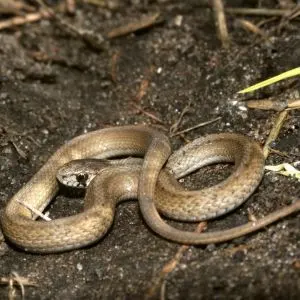
- Experience Level: Beginner
- Family: Colubridae
- Scientific Name: Storeria dekayi
- Other Names: Brown Snake, DeKay’s Brown Snake
- Adult Size: approximately 13 inches
- Lifespan: 7 years in captivity; unknown in the wild
- Average Price Range: $20 to $30 per snake
Brownsnakes are not shy and humans commonly encounter them. They can make great pets for beginners due to their size and gentle nature. They are also quite easy to feed.
These non-venomous snakes are usually brown in color, as their name suggests, but can also come in a yellowish, red, or grayish-brown tone.
They will typically have two rows of either darker or lighter spots which might also be linked, making it look like a collar or middorsal streak down the side of their head. Underneath each of their eyes may also be a small, dark spot.
These markings may also not appear on some individuals.
Their undersides will either be white or tan.
They like to reside in various woodlands, more commonly in wet areas like swamp edges or wetland borders. They like to roam the litters of abandoned fields, lowland hardwoods, prairies, and oak savannas.
They are also often spotted in residential areas or urbanized territories.
In their habitats, they will consume small invertebrates like earthworms, slugs, and snails with their specialized jaws and teeth. They may also eat beetles and salamanders if they come across one.
5. Florida Brown Snake
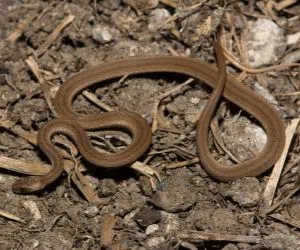
- Experience Level: Beginner
- Family: Colubridae
- Scientific Name: Storeria victa
- Other Names: Brown Snake, Florida Brownsnake
- Adult Size: 12 inches
- Lifespan: 7 years in captivity; unknown in the wild
- Average Price Range: $20 to $30 per snake
The Florida Brown Snake is one of the smallest species in the Storeria genus.
They are very similar to other Brown Snakes in appearance with a brown body, cream-colored belly, side scales, and rigged back with a tan line running through the length of them. Although, sometimes they will appear redder or copper in color in comparison to other Brown Snakes.
They thrive in various habitats but prefer moist environments with a lot of foliage like swamps, wetlands, hardwood hammocks, and even our backyards.
They are more active in the early evenings all the way into the night, feeding and hunting.
They will eat basically the same diet as DeKay’s Brown Snakes, which consume small invertebrates like earthworms, slugs, and snails with their specialized jaws and teeth. They may also eat beetles and salamanders if they come across one.
6. North American Blue Racer
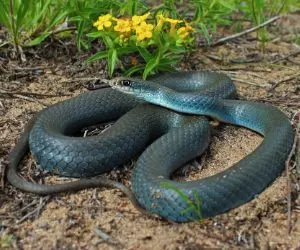
- Experience Level: Intermediate
- Family: Colubridae
- Scientific Name: Coluber constrictor
- Other Names: Black Racer, Racer, North American Racer
- Adult Size: Anywhere from 20 to 65 inches
- Lifespan: 10 years
- Average Price Range: $20 to $40 per snake (depending on size)
These slender snakes are versatile and are not dangerous or venomous. They are called racers due to their incredible speed.
They are mostly docile creatures. However, if they feel threatened, they are ready to defend themselves. In most cases, it can be quite hard for these snakes to become accustomed to handling.
These snakes are silvery-grey and can sometimes be an almost metallic-looking electric blue. North American Racers will have a pale yellow or white underside and a black tongue.
A bite from them is shocking but harmless to humans or larger pets like dogs or cats.
They inhabit young or regrowing forest edges and shrubland. These Racers feed on small mammals, insects, smaller snakes, and lizards by swallowing them alive.
7. Red-bellied Snake
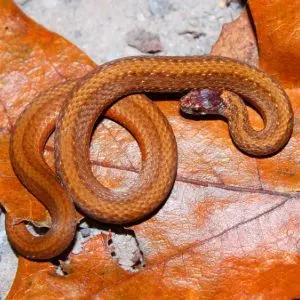
- Experience Level: Intermediate
- Family: Colubridae
- Scientific Name: Storeria occipitomaculata
- Other Names: Redbelly snake, Red-belly Snake
- Adult Size: 8 to 16 inches
- Lifespan: 4 years in captivity; Wild lifespan unknown but predicted to be longer than in captivity
These small snakes can be found in swarms basking in the sun on the warm days of September to October. You can also find them in woodlands, fields, under logs, in forests, bike trails, back roads, and sphagnum bogs.
In these areas, they feed on earthworms, beetle larvae, and slugs.
People can sometimes find them out in their pesticide-free garden or just out in the wild and might want to keep them as a pet. However, they really struggle to eat when in captivity and will sometimes just outright refuse when they are removed from the wild.
They do not do well in captivity and prefer to be free to roam the lands as they please. Although they aren’t hard to obtain in the wild, they might not be the best pet to keep if you are planning to have it for long since they do not do well away from their natural habitat.
It’s not hard to identify these snakes since they really do live up to their name with their flashy red or orange undersides. Their bodies might be a dark steel grey, black with a blue tint, or copper brown. Some may also have two dark stripes along their sides or a thick, light-colored band down the middle of their backs.
While they will usually first curl their tails or flee in defense before they try to bite, their little nibble probably won’t affect you anyway.
While they are small and beautiful, this does not mean they will make a good pet since they do not usually survive long in captivity.
8. Smooth Green Snake

- Experience Level: Intermediate
- Family: Colubridae
- Scientific Name: Opheodrys vernalis
- Other Names: Green Snake, Grass Snake, Green Grass Snake
- Adult Size: 14 to 20 inches
- Lifespan: 6 years
- Average Price Range: $8 to $10 per snake
Smooth Green snakes are carnivorous but prefer to feed on insects, making them somewhat insectivorous. This is the perfect reptile for owners that might be squeamish about feeding dead mice to their snakes.
These guys will mostly eat insects like spiders, moths, ants, snails, slugs, worms, and spineless caterpillars.
One drawback that does not make them great pets, though, is that they are way too timid for human interaction and are easily stressed. However, they are known to be docile and some might even enjoy being handled.
Just like their name suggests, these snakes have bright green scales, which can range in shade. They stay relatively small and may have a pale yellow underside with little, beady, black eyes.
They thrive in moist, grassy areas and can be found in open woods, stream edges, marshes, and meadows.
9. Gophersnake

- Experience Level: Intermediate
- Family: Colubridae
- Scientific Name: Pituophis catenifer
- Other Names: Gopher Snake
- Adult Size: 4 to 7 feet; can reach up to 9 feet
- Lifespan: 12 to 15 years; up to 30 years in captivity
- Average Price Range: $30 to $100 per snake
The Gopher Snakes are heavy-bodied, docile creatures except when threatened.
These guys will require a very secure enclosure as they are escape artists. They also require a lot of space due to their size and active nature.
Gopher snakes are usually a light tan to brown color with large, dark brown, sometimes reddish-brown spots and lined patterns throughout their length.
They can be found in pine or oak barrens, savannas, and sand prairies where they do a great job at keeping gopher populations from overabundance.
They really like to eat small rodents, which is actually how they got their name.
10. Bullsnake
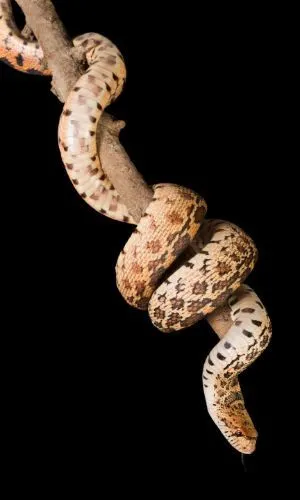
- Experience Level: Intermediate
- Family: Colubridae
- Scientific Name: Pituophis catenifer sayi
- Other Names: Bull Snake
- Adult Size: up to 8 feet
- Lifespan: up to 30 years in captivity; 12 years in the wild
- Average Price Range: around $200 per snake
Bullsnakes are a subspecies of the Gophersnake. They can make good pets once accustomed to handling and captivity, which is why you want to look for captive-bred species.
They are large constrictor snakes, though, meaning that they strangle their prey. This species will sometimes do this to more than one animal at a time. You also shouldn’t be too surprised if they try to bite.
Bullsnakes are often mistaken for rattlesnakes due to their similar behaviors. However, they are not as large, have round pupils, narrower heads, don’t have pits over their nostrils, and don’t have rattles on their tails.
These non-venomous snakes are hefty and large with a cream-colored or pale yellow body with brown, black, or copper blotching all throughout. Their heads and necks are almost the same in width as well.
They can be found in open country environments like old fields, native or bluff prairies, pastures, oak savannas, and steep hillsides. They roam sandy-soiled areas where rodents burrow and may also take shelter in agricultural fields, open forests, brush, and any sandy area.
These powerful constrictors live off gophers as well as other small mammals like mice and squirrels. They will also consume amphibians, birds, and their eggs.
11. Plains Hog-nosed Snake

- Experience Level: Beginner
- Family: Colubridae
- Scientific Name: Heterodon nasicus nasicus
- Other Names: Hognose snake
- Adult Size: 15 to 25 inches
- Lifespan: about 10 to 15 years
- Average Price Range: $100 to $500 per snake
The Plains Hognose snake is known to be one of the best pet snakes for enthusiasts since they are not fussy and are comfortable with human interaction.
They also stay relatively small and have a cute, lovable face with their tiny snout, as their name suggests.
These worm-like snakes have a small snout and a pug-like face. They are usually a light yellow or tan color with brown or copper blotches throughout their bodies.
They are known to be pretty easy to care for in terrariums and come from dry environments with low vegetation, abundant in rocks or stones. They enjoy digging and prefer sandy areas with space to burrow.
Hog-nosed snakes like to eat frogs and toads, even poisonous ones. However, they will also feed on lizards, small mammals like birds, insects, and salamanders.
12. Western Milksnake

- Experience Level: Beginner
- Family: Colubridae
- Scientific Name: Lampropeltis gentilis
- Other Names: King Snake
- Adult Size: 47 to 52 inches
- Lifespan: 20 years
- Average Price Range: $50 to $300 per snake
Western Milk Snakes are a species of Kingsnake that can often be confused with the dangerous Coral Snake because of their similar appearance. They are definitely friendly and will not try to bite you as a Coral Snake would.
Western Milk snakes have red, pale yellow, and black bands that loop around the length of their body. These can sometimes also appear as spots, depending on the Milk Snake.
They make good pets as they have a calm temperament and like most docile snakes, will only react defensively if they feel threatened.
They prefer to live in forests, but also like rock outcroppings, barns, agricultural land, and fields.
Milk Snakes are carnivorous and feed on lizards, reptile eggs, birds and their eggs, mice, and sometimes insects.
13. Prairie Rattlesnake

- Experience Level: Expert
- Family: Viperidae
- Scientific Name: Crotalus viridis
- Other Names: Western Rattlesnake, Great Plains Rattlesnake
- Adult Size: 5 feet
- Lifespan: 16 to 20 years in the wild; 24 years max in captivity
- Average Price Range: $100 to $200 per snake
The Prairie Rattlesnake is the only venomous snake in North Dakota. If you suffer a bite from this viper and don’t get it treated, it can be very dangerous, and even fatal.
This venomous pit viper is a tan, hefty rattlesnake with dark brown blotches or bands along their backsides, splitting into dark olive or brown rings at their tail.
They can be spotted in sagebrush, grasslands, and high rocky ledges. Prairie Rattlesnakes mostly consume various kinds of rodents.
Conclusion
We hope that you learned something from this article and that we were of any help to you on your search for native snakes and laws in North Dakota.
There are not many unique species of snakes in North Dakota, but nevertheless, there are some interesting ones to check out.
Let us know if we missed anything or if you have any further questions.
If you’re thinking about keeping one as a pet, tell us about it in the comments!
Snakes in other states
More Snake Stuff
References
- https://www.westfargond.gov/160/Animal-Licenses
- https://gf.nd.gov/gnf/conservation/docs/amphibian-reptile-brochure.pdf

Gail Baker Nelson
Tuesday 13th of June 2023
Pretty sure you’re not going to find a FLORIDA brownsnake in North Dakota’s habitat, unless someone’s pet happened to get out. Also, Dekay’s brownsnakes do NOT range that far north and west. You might be able to find one at the southern border of SOUTH Dakota but not in North Dakota.